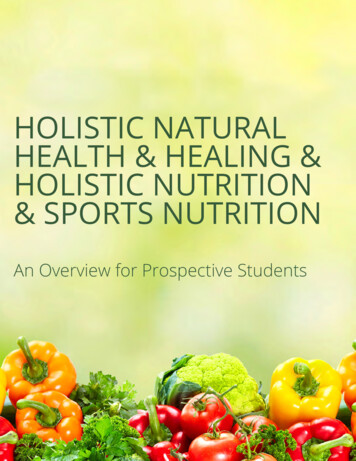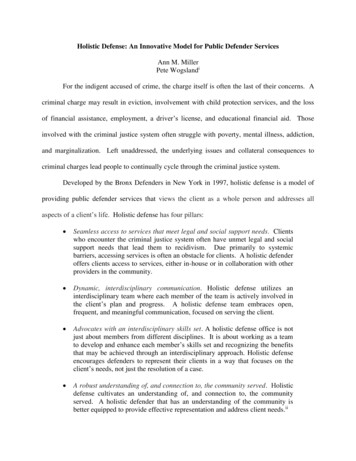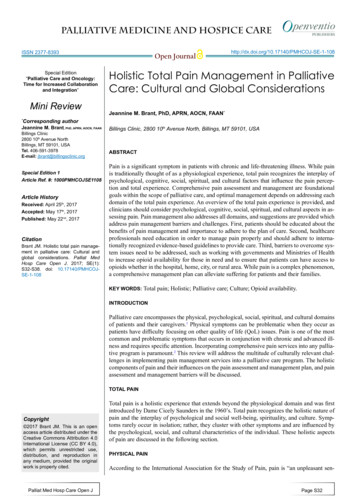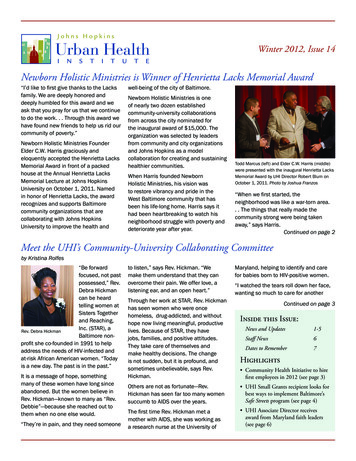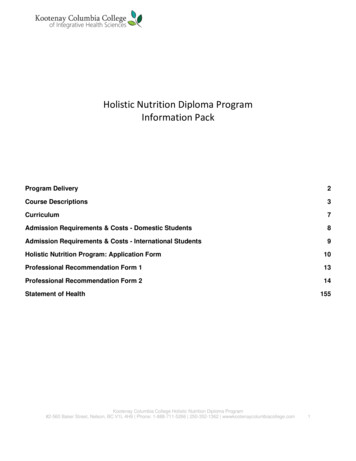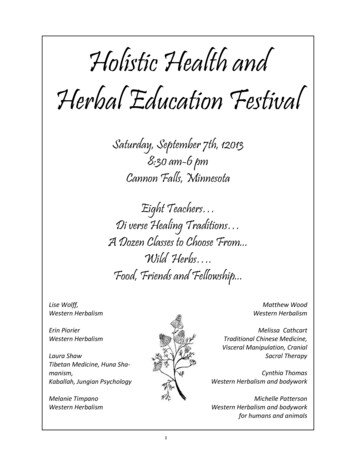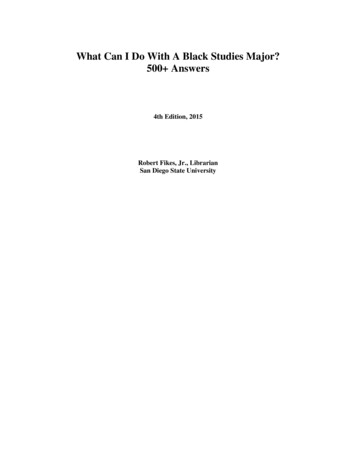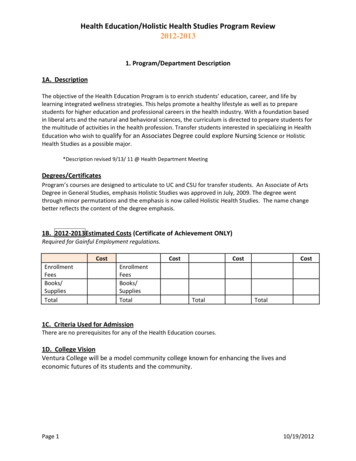
Transcription
Health Education/Holistic Health Studies Program Review2012-20131. Program/Department Description1A. DescriptionThe objective of the Health Education Program is to enrich students’ education, career, and life bylearning integrated wellness strategies. This helps promote a healthy lifestyle as well as to preparestudents for higher education and professional careers in the health industry. With a foundation basedin liberal arts and the natural and behavioral sciences, the curriculum is directed to prepare students forthe multitude of activities in the health profession. Transfer students interested in specializing in HealthEducation who wish to qualify for an Associates Degree could explore Nursing Science or HolisticHealth Studies as a possible major.*Description revised 9/13/ 11 @ Health Department MeetingDegrees/CertificatesProgram’s courses are designed to articulate to UC and CSU for transfer students. An Associate of ArtsDegree in General Studies, emphasis Holistic Studies was approved in July, 2009. The degree wentthrough minor permutations and the emphasis is now called Holistic Health Studies. The name changebetter reflects the content of the degree emphasis.1B. 2012‐2013Estimated Costs (Certificate of Achievement ONLY)Required for Gainful Employment otal1C. Criteria Used for AdmissionThere are no prerequisites for any of the Health Education courses.1D. College VisionVentura College will be a model community college known for enhancing the lives andeconomic futures of its students and the community.Page 110/19/2012
Health Education/Holistic Health Studies Program Review2012-20131E. College MissionVentura College, one of the oldest comprehensive community colleges in California, provides apositive and accessible learning environment that is responsive to the needs of a highly diversestudent body through a varied selection of disciplines, learning approaches and teachingmethods including traditional classroom instruction, distance education, experiential learning,and co‐curricular activities. It offers courses in basic skills; programs for students seeking anassociate degree, certificate or license for job placement and advancement; curricula forstudents planning to transfer; and training programs to meet worker and employee needs. It isa leader in providing instruction and support for students with disabilities. With its commitmentto workforce development in support of the State and region's economic viability, VenturaCollege takes pride in creating transfer, career technical and continuing education opportunitiesthat promote success, develop students to their full potential, create lifelong learners, enhancepersonal growth and life enrichment and foster positive values for successful living andmembership in a multicultural society. The College is committed to continual assessment oflearning outcomes in order to maintain high quality courses and programs. Originallylandscaped to be an arboretum, the College has a beautiful, park‐like campus that serves as avital community resource.1F. College Core CommitmentsVentura College is dedicated to following a set of enduring Core Commitments that shall guideit through changing times and give rise to its Vision, Mission and Goals. Student SuccessInnovation RespectDiversity IntegrityService QualityCollaboration CollegialitySustainability AccessContinuous ImprovementPage 210/19/2012
Health Education/Holistic Health Studies Program Review2012-20131G. Program/Department Significant Events (Strengths and Successes)1. There is strong growth in the Health Education program. There is an increase in the studentretention rate and the student success, which continuously surpasses the college retention andsuccess rate.2. The interest in the holistic studies degree and the popularity of the holistic health program hasgrown exponentially in the two years of the program’s existence.3. We coordinate and host an annual Holistic Health Fair in conjunction with a Holistic WellnessWeek during the month of April. Our third annual holistic health festival was held on April 11,2012. The event grows each year in attendance. We have a week of guest speakers, films, andother activities for students, holistic health care professionals, and members of the community.Wellness Week provides professional networking opportunities for our holistic health students.4. In partnership with the Ventura College Holistic Health and Wellness Club, 7000 wascollected in order to create a 1000 annual Osher Scholarship,in perpetuity, for holistic healthstudents!a. Our first Osher Scholarships, two 500 scholarships and our first Holistic StudiesGraduate Scholarship ( 1000) were awarded to three holistic studies students at theVentura College Foundation’s Scholarship Luncheon in April 2012. Health Educationfaculty were present to award the scholarships.5. Partnerships have been formed with holistic health care providers in West Ventura County todevelop a holistic health care directory, which are available to our students and the community.6. In the first two years, students of the program were employed in the holistic health care field.7. Holistic Studies students are transferring to colleges and universities including Acupuncture andTraditional Chinese Medicine Colleges. Others are transferring to universities to study nutrition.8. There is a community advisory board for the program and it is comprised primarily of healthcare professionals in Ventura County.9. Every semester it is documented and recorded that a highly significant number of studentstaking health education courses make major (and potentially lifesaving) health lifestyle changessuch as smoking and drug cessation, reducing binge drinking, developing good nutrition,improving their cardiovascular, respiratory and muscular fitness.10. The Health Education Department pioneered the introduction of classroom response technology(clickers) in the classroom. We have continue to present clicker training workshops for allfaculty during flex week.Page 310/19/2012
Health Education/Holistic Health Studies Program Review2012-201311. The Health Education Department has applied for and received numerous grants through theVentura College Foundation. We have updated and enhanced our instructional resourcesthrough these foundation grants.12. Three proficiency awards in Holistic Health were earned at the completion of the spring, 2011school year.13. The Health Education Department hosted a Proposition 37 GMO Education Symposium October8, 2012. Over 350 people attended the event.14. The Health Education Department in partnership with the Holistic Health Club is sponsoring theFirst Annual Holistic Health Film Festival October 11‐12. We are also sponsoring holistic healthweek October 8 – 12.15. The Health department is collaborating with the English department (as part of learningcommunities) and offering students a health topic related essay contest. This semester’s topic isGMOs. A health related essay contest will be continued on a yearly or a semester basis.Page 410/19/2012
Health Education/Holistic Health Studies Program Review2012-2013K. Organizational StructurePresident: Robin CaloteExecutive Vice President: Ramiro SanchezDean: Tim HarrisonDepartment Chair: Raeann Koerner and Terry Morris (co‐chairs)Instructors and StaffNameClassificationYear HiredYears of Work‐Related ExperienceDegrees/CredentialsKoerner, RaeannProfessor1982NameClassificationYear HiredYears of Work‐Related ExperienceDegrees/CredentialsMorris, Terry JProfessor1997NameClassificationYear HiredYears of Work‐Related ExperienceDegrees/CredentialsCowen, WilliamAthletics Director2009NameClassificationYear HiredYears of Work‐Related ExperienceDegrees/CredentialsEliot, MaureenProfessor2004NameClassificationYear HiredYears of Work‐Related ExperienceDegrees/CredentialsFredrickson, NancyProfessor1999NameClassificationYear HiredYears of Work‐Related ExperienceDegrees/CredentialsRamirez, JoeyProfessorPage 5B.A., M.A.B.S., M.A.B.A., M.A.B.A., M.A.B.A., M.A.2011B.S., M.A.10/19/2012
Health Education/Holistic Health Studies Program Review2012-2013Notes:*Will Cowen has never taught any Health Education classes at Ventura College;only Kinesiology classesPage 610/19/2012
Health Education/Holistic Health Studies Program Review2012-20132. Performance Expectations2A. Student Learning Outcomes2A1. 2012‐2013 ‐ Institutional Student Learning Outcomes1. Communication ‐ written, oral and visual2. Reasoning ‐ scientific and quantitative3. Critical thinking and problem solving4. Information literacy5. Personal/community awareness and academic/career responsibilities2A2. 2012‐2013‐ Program Level Student Learning OutcomesFor programs/departments offering degrees and/or certificates1. Identify, assess, and implement personal wellness behaviors and individual healthpromotion strategies.2. Identify the primary factors influencing the multi‐dimensional aspects of health.3. Explore transfer and career opportunities in various health related professions4. Analyze and discuss the interconnectedness of the mind, body and spirit.2A3. 2012‐2013 ‐ Course Level Student Learning OutcomesAttached to program review (See appendices).2B. 2012‐2013 Student SUCCESS Outcomes1. The program will maintain its high retention rate of 89% or increase its retention rate from theaverage of the program’s prior three‐year retention rate2. The program will increase its retention rate from the average of the college’s prior three‐yearretention rate. The retention rate is the number of students who finish a term with any gradeother than W or DR divided by the number of students at census.Page 710/19/2012
Health Education/Holistic Health Studies Program Review2012-20132C.2012‐2013 Program OPERATING Outcomes1. The program will maintain or increase WSCH/FTEF above the 525 goal (650) set by thedistrict2.No inventory of health education supplies has been tracked.2D. Mapping of Student Learning Outcomes ‐ Refer to TracDat3. Operating Information3A. Productivity Terminology TableSectionsCensusFTESFTEFCrossListedFTEFXL FTEPage 8A credit or non‐credit class.Does not include not‐for‐credit classes (community education).Number of students enrolled at census (typically the 4th week of class for fall and spring).Full Time Equivalent StudentsA student in the classroom 15 hours/week for 35 weeks (or two semesters) 525student contact hours.525 student contact hours 1 FTES.Example: 400 student contact hours 400/525 0.762 FTES.The State apportionment process and District allocation model both use FTES as theprimary funding criterion.Full Time Equivalent FacultyA faculty member teaching 15 units for two semesters (30 units for the year) 1 FTE.Example: a 6 unit assignment 6/30 0.20 FTEF (annual). The college also computessemester FTEF by changing the denominator to 15 units. However, in the programreview data, all FTE is annual.FTEF includes both Full‐Time Faculty and Part‐Time Faculty.FTEF in this program review includes faculty assigned to teach extra large sections (XLFaculty). This deviates from the prior practice of not including these assignments as partof FTEF. However, it is necessary to account for these assignments to properly representfaculty productivity and associated costs.FTEF is assigned to all faculty teaching cross‐listed sections. The FTEF assignment isproportional to the number of students enrolled at census. This deviates from thepractice of assigning load only to the primary section. It is necessary to account for thesecross‐listed assignments to properly represent faculty productivity and associated costs.Extra Large FTE: This is the calculated assignment for faculty assigned to extra largesections (greater than 60 census enrollments).The current practice is not to assign FTE.Example: if census 60, 50% of the section FTE assignment for each additional group of25 (additional tiers).10/19/2012
Health Education/Holistic Health Studies Program Review2012-2013WSCHWSCH toFTESDistrictGoalWeekly Student Contact HoursThe term “WSCH” is used as a total for weekly student contact hours AND as the ratio ofthe total WSCH divided by assigned FTEF.Example: 20 sections of 40 students at census enrolled for 3 hours per week taught by4.00 FTEF faculty. (20 x 40 x 3) 2,400 WSCH / 4.00 FTEF 600 WSCH/FTEF.Using the example above: 2,400 WSCH x 35 weeks 84,000 student contact hours 84,000 / 525 160 FTES (see FTES definition).Simplified Formulas: FTES WSCH/15 or WSCH FTES x 15Program WSCH ratio goal. WSCH/FTEFThe District goal was set in 2006 to recognize the differences in program productivity.3B: Student Success TerminologyCensusRetainSuccessNumber of students enrolled at Census (typically the 4th week of class for fall andspring). Census enrollment is used to compute WSCH and FTES for funding purposes.Students completing the class with any grade other than W or DR divided by CensusExample: 40 students enrolled, 5 students dropped prior to census,35 students wereenrolled at census, 25 students completed the class with a grade other than W or DR:Retention Rate 25/35 71%Students completing the class with grades A, B, C, CR or P divided by CensusExcludes students with grades D, F, or NC.Program specific data was provided in Section 3 for all programs last year. This year, pleaserefer to the data sources availableathttp://www.venturacollege.edu/faculty staff/academic resources/program review.shtmlIn addition, the 2011‐2012 program review documents will provide examples of last year’sdata and interpretations.3C:2012 ‐ 2013Please provide program interpretation for the following:3C1: Interpretation of the Program Budget InformationThe numbers stated in the chart below for FY 12 may be skewed. We have an additional full‐time facultymember, Joey Ramirez, teaching 40% of his load in the health discipline.Page 910/19/2012
Healthh Educatioon/Holisticc Health Sttudies Proggram Revieew20012-2013Category123456789Page 10TitleFT FacultyPT ��‐548,4253 20ProogramCollegeChhangeChangefromm Prior from PriorThreee Year Threee �18%568,2170%10/19//2012
Healthh Educatioon/Holisticc Health Sttudies Proggram Revieew20012-20133C2: Inteerpretation of the Progrram Inventoory /pdf//program Programm.pdfNo invenntory for heaalth educatioon is listed. WeW do havee DVDs and innstructional supplies thaatwe keep in a health supplyscloset.Page 1110/19//2012
Health Education/Holistic Health Studies Program Review2012-20133C3: Interpretation of the Program Productivity InformationThe FTES and WSCH have increased each year due to the popularity of the Health Education Programwith the students. The number of health education sections increased due to several factors:1. The 15% increase in the number of sections is in part due to Health Education departmentabsorbing two Nutrition Classes last year, which, past practice were funded entirely by theHome Economics Department. (The Nutrition course, previously, HEC V10, is now HED V87)Course review showed the Nutrition courses belonged with Health Education. Past practiceshows the Nutrition class offered twice each semester – one in the day and one in the evening.We are continuing this schedule2. Student demand: Health Education is a requirement for the majority of Associate of Arts andAssociate of Sciences degrees offered at Ventura College.3. Health Education is in the same division as Kinesiology . Kinesiology lost several course offeringsdue to many factors beyond the control of the department. Because of these course deletionsin our kinesiology offerings, and student demand, we added a couple health classes.4. Increased popularity of the holistic health studies A.A. degree increased the demand by thestudents for more sections. The department is attempting to offer the core required courses inthe degree such that a student could earn the degree either as a day or an evening student. Weadded a couple of classes this fall, 2012 to give more opportunities to students pursuing thedegree.5. The 32% decrease in XL faculty is due to capping the enrollment of our online health educationclasses. This was both an administrative decision and a philosophy decision by the departmentconcerning the quality of teaching in the XL online classes.Health Education: Productivity ChangesTitleSectionsCensusFTESFT FacultyPT FacultyXL FacultyTotal FacultyWSCHWSCH/FacultyPage 0.657.385,1006913 %‐24%‐5%‐6%‐2%10/19/2012
Healthh Educatioon/Holisticc Health Sttudies Proggram Revieew20012-20133C4: Inteerpretation of the Progrram Course Productivityy InformatioonThe produuctivity for the health education prograam exceeds thhe district’s ggoals. The disstrict goal forhealth education classes is 650. Thee programs avverage is 656 , which is 1011% of the disttrict’s goals.Most of thhe classes aree equal to or greatergthan the district’s goal. The class sections thhat didn’t meetthe goal werewthose claasses where thet class size is limited by the size of thhe classroom or by themaximumm enrollment. Classes like HED V94 Thee Trainer and Athletic Injurries and HED V92, First Aidd andCPR are caapped at 30 dued to the nature of the workwin the claass.The higheest numbers area for the core courses in the Holistic SStudies Degreee (HED V70, HED V73, HEDV91) and for HED V87 (Nutrition)Page 1310/19//2012
Health Education/Holistic Health Studies Program Review2012-2013College WSCH Ratio: Weekly Student Contact Hours/(FT FTE PT FTE XL Page 14TitleFY09Spiritual Health573Spiritual Health‐Holistic Health and Healing‐Managing Stress‐Health and Fitness‐CPR for Professional Rescuers389Nutrition‐Directd Study:Health Education‐Survey of Alternative Medicine505420First Aid, Safety and CPRHealth and Wellness613Trainer and Athletic Injuries769Health and Wellness: Women595Fundmntls Nutrition & Fitness630594Annual College WSCH Ratio for FY11‐773700791‐328‐‐6235347112917537466903 Yr nge Dist 50147650(11)6501650(176)650(0)650(124)6502650% %101%10/19/2012
Healthh Educatioon/Holisticc Health Sttudies Proggram Revieew20012-2013Page 1510/19//2012
Health Education/Holistic Health Studies Program Review2012-20133C5: Interpretation of Program Retention, Student Success, and Grade DistributionStudent Retention:The Health Education Program has consistently achieved a higher retention rate than the overall collegeretention rate. For the average of the past three years, the health education retention rate was 90%compared to the college wide retention rate of 85% for the same time period. That is 5% higher thanthe college wide retention rate. There was also an increase of 1% from the 3 year average to FY 12 inthe retention rate of students in the health education program.Some of the factors that may contribute to this high retention rate are: Student interest in the materialRelevance to the student’s livesThe encouragement of classroom discussionsSmall group discussions which peak student interestThe holistic health studies A.A. degree programThe HED requirement for most A.A. and A.S. DegreesStudent Success:The Health Education student success rate was 74% over the past three years as compared withthe college’s overall success rate of 69% for the same time period. This is a 1 % increase instudent success in health classes as compared to last year, FY11. This is five (5) percentagepoints higher than the college wide average student success rate! Comparing FY12 collegesuccess rate (71%) to health department success rate (77%) shows a 6% higher success rate tothe overall FY12 college wide success rate. The grade distribution does appear heavy on thenumber of “A”s earned. This may be reflective of the clear expectations delineated on thecourse syllabi, the interest in the subject by the students, and possibly the nationwide trendtoward grade inflation.Subject Fiscal YearHEDFY09HEDFY10HEDFY11HED3 Year AvgHEDFY12Page 8NP/NC1‐213W379307350345359Graded Completed 833,4453,0992,5583,8913,5322,97910/19/2012
Healthh Educatioon/Holisticc Health Sttudies Proggram Revieew20012-2013Subject Fiscal YearHEDFFY09HEDFFY10HEDFFY11HED3 Year AvgHEDFFY12College 3 Year AvgCollege FYY12Page %110%1%9%1%WGraded Completed %86%10/19//2012
Healthh Educatioon/Holisticc Health Sttudies Proggram Revieew20012-2013Page 1810/19//2012
Health Education/Holistic Health Studies Program Review2012-20133C6: Interpretation of the Program Completion InformationThe General Studies, Pattern 1: Emphasis Holistic Studies Associate of Arts Degree wasestablished in July 2009. The degree program has been in existence for three years. There was onegraduate the first year, three graduates the second year, and 13 graduates in 2012! This totals 17graduates in three years. Three proficiency awards were earned in 2012, totaling 7 since the programbegan three years ago. The graduation rates of holistic studies students have increased exponentially.Page 1910/19/2012
Healthh Educatioon/Holisticc Health Sttudies Proggram Revieew20012-2013Hollistic Studies: Studdent Certificaates and istic StudiesFY09‐Hollistic StudiesFY10‐1Hollistic StudiesFY11‐33Hollistic StudiesFY12‐13121‐17152Total Awaards in 4 Yearss‐‐‐1‐‐Health Edducation : Stuudent Certifi cates and ationHealth EdFY09‐‐‐‐Health EdducationFY10‐‐‐‐Health EdducationFY11‐‐‐‐Health EdducationFY12‐‐‐‐‐‐‐‐Total Awaards in 4 YearssPage 2010/19//2012
Health Education/Holistic Health Studies Program Review2012-20133C7: Interpretation of the Program Demographic InformationThe health education demographics closely mirror the college’s combined demographics with respect toethnicity. The demographic trend has remained relatively constant over the past four years.With regard to gender, there is a significant deviation from the college demographics. The 3 yearcollege ratio of females to males is 53/46. The 3 year health education program ration is 60/40.FYHispanicFY091,512FY101,623FY111,6203 Year Avg1,585FY121,9363 Year Avg 749,875Asian Afr Am761187912579153781321001949901,0749661,157Pac Isl3334303230223183Filipino Nat Am9747885110948984910061880414842390Other 0 16,2211,424 15,137FYHispanic WhiteAsian Afr Am Pac Isl Filipino Nat Am Other %6%61%FY1146%37%2%4%1%3%1%6%61%3 Year Avg46%37%2%4%1%3%1%6%60%FY1250%34%3%5%1%3%2%4%60%3 Year age 21Male1,3411,3591,3861,3621,55213,26113,183Other Avg Age8261125625825924972711525MaleOther Avg 2410/19/2012
Healthh Educatioon/Holisticc Health Sttudies Proggram Revieew20012-2013Page 2210/19//2012
Health Education/Holistic Health Studies Program Review2012-20134. Performance Assessment4A1:2012‐2013Institutional Level Student Learning OutcomesInstitutional Level StudentLearning Outcome 1CommunicationPerformance Indicators80% of the students will achieve a C or higher according to theinstitutional communication rubric for written communicationOperating InformationThis ISLO will be assessed in HED V73 this yearAnalysis – AssessmentThis ISLO will be assessed in November, 2012Institutional Level StudentLearning Outcome 2Reasoning – Scientific andQuantitativePerformance IndicatorsThis ISLO will not be assessed by Health EducationOperating InformationAnalysis – AssessmentInstitutional Level StudentLearning Outcome 3Critical Thinking andproblem solvingPerformance IndicatorsThis ISLO will be assessed in Fall 2013 and Spring 2014 per the ISLOinstitutional calendarOperating InformationAnalysis – AssessmentNo data yetPage 2310/19/2012
Health Education/Holistic Health Studies Program Review2012-2013Institutional Level StudentLearning Outcome 4Performance IndicatorsInformation LiteracyOperating InformationThis ISLO will be assessed at the time determined by the collegeAnalysis – AssessmentNo data yetInstitutional Level StudentLearning Outcome 5Performance IndicatorsPersonal/communityawareness and academic /career responsibilitiesOperating InformationThis ISLO will be assessed in Fall of 2014 and Spring of 2015 per the institutional ISLO calendar.Analysis – AssessmentNo data yetPage 2410/19/2012
Health Education/Holistic Health Studies Program Review2012-20134A2: 2012‐2013 Program Level Student Learning Outcomes ‐ For programs/departmentsoffering degrees and/or certificatesProgram‐Level Student Learning Outcome 1Identify, assess, and implement personalwellness behaviors and individual healthpromotion strategies.Performance IndicatorsStudents take a pre test, post test assessment oftheir health behaviors. They evaluate any change intheir health behaviors. The goal is that 80% of thestudents improve in 3 or more dimensions ofwellness.Operating InformationThis PSLO was assessed during the fall 2012 semester in HED V 95. The health instructors developed aconsistent methodology for assessment at the department meeting.Analysis – AssessmentProgram‐Level Student Learning Outcome 2Identify the factors influencing the multi‐dimensional aspects of health.Performance IndicatorsA written quiz will be developed and given tostudents in identified classes. The goal is 80% ofstudents will score 80% or higher on the writtenquiz.Operating InformationThis PSLO is being assessed fall 2012 in the HED V73 classesAnalysis – AssessmentPage 2510/19/2012
Health Education/Holistic Health Studies Program Review2012-2013Program‐Level Student Learning Outcome 3Explore transfer and career opportunities invarious health related professionsPerformance IndicatorsA quiz will be given in HED V91. The goal is 80% ofthe students will score 70% or better on the writtenquiz.Operating InformationThis PSLO will be assessed in Fall 2013Analysis – AssessmentProgram‐Level Student Learning Outcome 4Analyze and discuss the interconnectednessof the mind, body and spirit.Performance IndicatorsShort essayOperating InformationThis PSLO will be assessed November, 2012.Analysis – Assessment4A3: 2012‐2013 Course Level Student Learning Outcomes ‐ Refer to TracDatPage 2610/19/2012
Health Education/Holistic Health Studies Program Review2012-20134B: 2012‐2013Student Success OutcomesStudent Success Outcome 1The program will maintain its high retention rateof 89% or increase its retention rate from theaverage of the program’s prior three‐yearretention rate. The retention rate is the numberof students who finish a term with any gradeother than W or DR divided by the number ofstudents at census.Performance IndicatorsThe program will increase its retention rate of by 2% orhigher.Operating InformationHealth Education’s prior three year average retention rate was 89%. Health Educations FY11’s retention ratewas 90%Analysis – AssessmentThe Health Education department or increased its student retention rate by 1%.Student Success Outcome 2The program will increase its retention rate fromthe average of the college’s prior three‐yearretention rate. The retention rate is the numberof students who finish a term with any gradeother than W or DR divided by the number ofstudents at census.Performance IndicatorsThe program will increase the retention rate by 2% ormore above the average of the college retention rate forthe prior three years.Operating InformationThe college’s 3 year retention rate was 85% The Health Education’s FY11 retention rate was 90%Analysis – AssessmentHealth Education was five percentage points higher than the college wide retention rate.Page 2710/19/2012
Health Education/Holistic Health Studies Program Review2012-20134C. 2012‐2013 Program Operating OutcomesProgram Operating Outcome 1Performance IndicatorsThe program will maintain orincrease WSCH/FTEF abovethe 525 goal set by thedistrictWhere possible, due to classroom maximum capacities, theprogram will exceed the efficiency goal set by the district by 1%Operating InformationHealth classes were at 101% of the 525 goal.Analysis – AssessmentAnalyzing the individual course WSCH numbers, it is evident that meeting or exceeding the district goalin health is entirely dependent upon the size of the classroom.Program Operating Outcome 2Performance IndicatorsOperating InformationAnalysis – Assessment4D. Program Review Rubrics for Instructional ProgramsPoint ValueUp to 6Up to 6Up to 4Up to 4Up to 3Up to 3Total Pointsj22 – 2618 – 21Below 18Academic ProgramsElementEnrollment demandSufficient resources to support the program (ability
Health Education/Holistic Health Studies Program Review 2012-2013 Page 1 10/19/2012 1. Program/Department Description 1A. Description The objective of the Health Education Program is to enrich students' education, career, and life by learning integrated wellness strategies.
